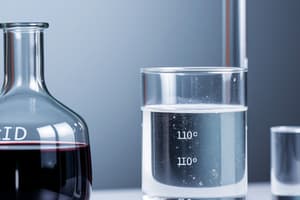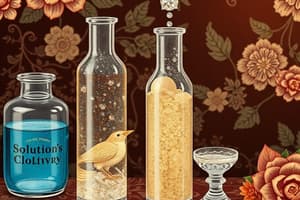Podcast
Questions and Answers
What components make up a solution?
What components make up a solution?
- A solute and a solvent (correct)
- Only a solvent
- Only a solute
- A solute, a solvent, and a precipitate
Which of the following statements correctly describes a saturated solution?
Which of the following statements correctly describes a saturated solution?
- A solution with equal amounts of solute and solvent
- A solution containing only pure substances
- A solution that can dissolve more solute
- A solution where no more solute can dissolve in the solvent (correct)
How does temperature generally affect the solubility of a solute in water?
How does temperature generally affect the solubility of a solute in water?
- Solubility increases with increasing temperature (correct)
- Solubility decreases with increasing temperature
- Solubility remains constant regardless of temperature
- Temperature has no effect on solubility
Which of the following describes a pure substance?
Which of the following describes a pure substance?
What is the main characteristic of a mixture?
What is the main characteristic of a mixture?
Which factor can affect the rate of solubility of a solute in a solvent?
Which factor can affect the rate of solubility of a solute in a solvent?
Which of the following is NOT a type of solvent?
Which of the following is NOT a type of solvent?
What happens if you continue to add solute to a solvent after reaching saturation?
What happens if you continue to add solute to a solvent after reaching saturation?
What method would you use to separate sand from a mixture of sand and water?
What method would you use to separate sand from a mixture of sand and water?
Which of the following describes a diatomic molecule?
Which of the following describes a diatomic molecule?
What is the meaning of the chemical formula H2O?
What is the meaning of the chemical formula H2O?
In the periodic table, where are metals primarily located?
In the periodic table, where are metals primarily located?
Which property is commonly associated with non-metals?
Which property is commonly associated with non-metals?
What does the suffix 'ate' typically indicate in a compound?
What does the suffix 'ate' typically indicate in a compound?
Which separation method is used to obtain pure water from a salt solution?
Which separation method is used to obtain pure water from a salt solution?
What is Dalton's model of the atom characterized by?
What is Dalton's model of the atom characterized by?
Study Notes
Solutions and Solubility
- Solutions are formed from a solute (the substance being dissolved) and a solvent (the liquid in which the solute dissolves).
- Particle theory explains that in a solution, particles of solute are surrounded by solvent particles, leading to dispersion and interaction.
- Common examples of solvents include water, ethanol, and white spirit; solutes can be solids, liquids, or gases, such as salt or carbon dioxide.
- A saturated solution occurs when no more solute can dissolve in the solvent, despite further addition.
- The solubility of a solute is defined as the maximum amount that can dissolve in a specific volume of solvent under certain conditions.
- Solubility can be affected by the nature of the solvent and the temperature; heating usually increases solubility.
- Factors influencing the rate of solubility include agitation, temperature, and the surface area of the solute.
Pure Substances and Mixtures
- A pure substance consists of only one type of element or compound, while a mixture contains two or more substances that are not chemically bonded.
- Solids that dissolve in water are termed soluble; those that do not dissolve are insoluble.
- The total mass of a solution equals the mass of the solute added to the mass of the solvent.
Separation Methods
- Filtration: Separates an insoluble solid from a liquid, e.g., sand from sand and water mixture.
- Evaporation: Used to separate a soluble solid from a liquid, e.g., salt from salt solution.
- Distillation: Involves evaporation followed by condensation to separate a solvent from a solution, e.g., pure water from salt solution.
- Fractional distillation: Separates liquids with different boiling points, useful for refining crude oil.
- Chromatography: Identifies different substances dissolved in a liquid, such as the colors in ink.
Structure of Matter
- An atom is the smallest part of an element. Dalton proposed that atoms are solid spheres divide into smaller parts.
- An element consists of one type of atom, like O2 (oxygen) or Fe (iron).
- A molecule is two or more atoms bonded together, e.g., H2O (water).
- A diatomic molecule contains two atoms of the same element, e.g., O2 or Cl2.
- Chemical symbols are one or two-letter codes representing elements, found in the periodic table.
- A compound is formed when two or more types of atoms are chemically bonded, e.g., CO2 (carbon dioxide).
- A chemical formula indicates the types and numbers of atoms in a molecule.
Chemical Reactions
- Physical changes involve changes in state but do not produce new substances.
- Chemical changes (reactions) occur when atoms rearrange to create new substances.
- Metals are found on the left in the periodic table, while non-metals are on the right.
- The modern periodic table was designed by Mendeleev, organized in groups (columns) and periods (rows).
Properties of Metals and Non-Metals
- Metals: Good conductors of electricity and heat, shiny, high density, malleable, ductile, hard, and have high melting points (except mercury).
- Non-metals: Poor conductors of electricity and heat, dull, low density, brittle, non-sonorous, and low melting points.
Studying That Suits You
Use AI to generate personalized quizzes and flashcards to suit your learning preferences.
Description
This quiz explores the concepts of solutions and solubility, detailing the roles of solutes and solvents. It discusses factors that influence solubility, such as temperature and agitation, and explains the concept of saturated solutions. Test your knowledge on these fundamental chemistry concepts.




